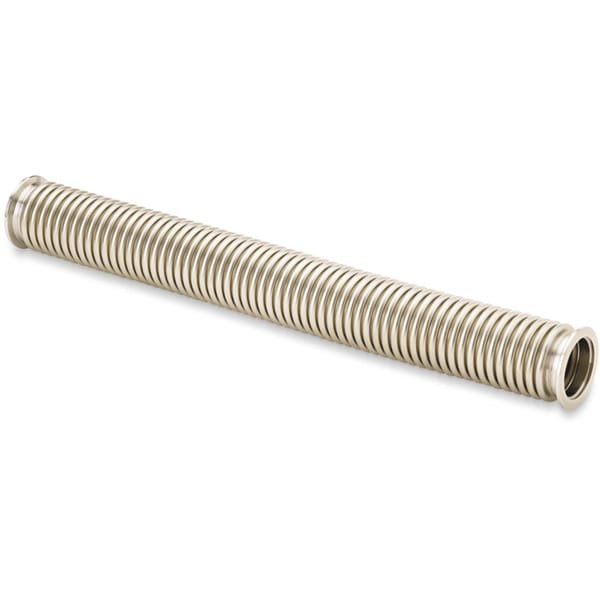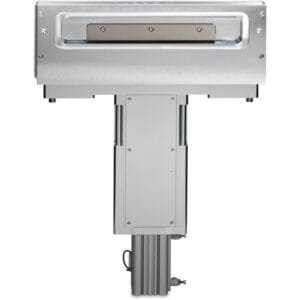Hydraulically (Hydro) Formed Bellows – KF (QF) Flanged (Standard Unbraided Wall)
Introduction
Hydraulically formed bellows with KF (also known as QF or NW) flanges are precision-engineered vacuum components designed to absorb mechanical movement, reduce vibration, and maintain reliable vacuum integrity. The hydroforming process creates seamless, corrugated bellows with uniform wall thickness, providing superior flexibility and durability compared to mechanically welded alternatives. These bellows are widely used in vacuum systems, semiconductor equipment, and research facilities where precise alignment and mechanical isolation are critical.
Detailed Description
Hydraulically formed bellows are produced from high-quality stainless steel tubing that is expanded under controlled hydraulic pressure into a die, forming consistent convolutions without weld seams. This results in a smooth internal surface, minimal particle generation, and longer service life.
Key features include:
Standard KF/QF Flanges – compatible with quick-clamp vacuum connections for fast, tool-free assembly.
Unbraided Wall Design – allows maximum axial, lateral, and angular flexibility.
Leak-Tight Construction – helium leak-tested to ensure ultra-high vacuum (UHV) compatibility.
Durable Stainless Steel (304/316L) – resists corrosion and provides excellent mechanical strength.
Clean, Particle-Free Fabrication – ideal for sensitive vacuum processes.
Applications
Hydraulically formed KF (QF) bellows are commonly used in:
Vacuum Systems – flexible connections for pumps, gauges, and fittings.
Semiconductor Manufacturing – vibration isolation and alignment adjustments.
Research Laboratories – high-vacuum and UHV experimental setups.
Optics & Laser Systems – minimizing vibration transfer in precision instruments.
General Industry – vacuum coating, analytical instruments, and process equipment.
Technical Parameters
| Parameter | Typical Value / Range | Importance |
|---|---|---|
| Flange Standard | KF16 – KF50 (QF/NW) | Covers common quick-clamp sizes |
| Material | Stainless Steel 304 / 316L | Corrosion resistance, durability |
| Length | 100 – 1000 mm (customizable) | Matches system design needs |
| Wall Thickness | 0.15 – 0.25 mm | Balances flexibility and strength |
| Leak Rate | ≤ 1×10⁻⁹ mbar·L/s | Ensures vacuum reliability |
| Temperature Range | -196 °C to +450 °C | Suitable for cryogenic and high-temp use |
Comparison with Related Products
| Type of Bellows | Key Advantage | Typical Use |
|---|---|---|
| Hydroformed (Unbraided) KF | Maximum flexibility, seamless | General vacuum applications |
| Braided KF Bellows | Higher pressure resistance | Systems with pressure surges |
| Mechanically Welded Bellows | Lower cost, less flexible | Basic vacuum piping |
FAQ
| Question | Answer |
|---|---|
| What is the difference between hydroformed and welded bellows? | Hydroformed bellows are seamless, cleaner, and longer-lasting, while welded bellows are lower-cost but less flexible. |
| Can these bellows handle ultra-high vacuum (UHV)? | Yes, they are helium leak-tested and suitable for high and ultra-high vacuum systems. |
| Are custom lengths and flange sizes available? | Yes, we provide tailored dimensions upon request. |
| Do they require external support? | For high-pressure or long lengths, external support or braiding may be recommended. |
| How are they packaged? | Each bellow is capped, cleaned, and individually packed to maintain cleanliness during storage and shipping. |
Packaging
All Hydroformed KF (QF) Bellows are cleaned for vacuum service, end-capped to prevent contamination, and sealed in protective packaging. They are shipped in sturdy cartons with labeling for quick identification and safe transport.
Conclusion
Hydraulically (Hydro) Formed Bellows with KF (QF) flanges provide unmatched flexibility, durability, and leak-tight performance for vacuum systems. Their seamless design ensures long-term reliability in semiconductor, laboratory, and industrial environments.
For detailed specifications and a quotation, please contact us at [sales@thinfilmmaterials.com].





Reviews
There are no reviews yet.